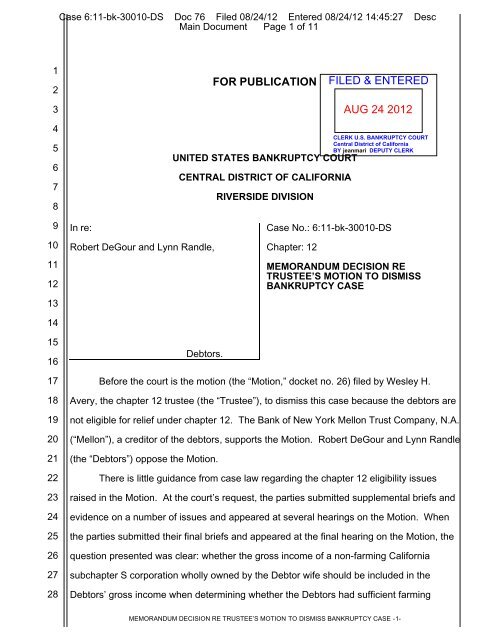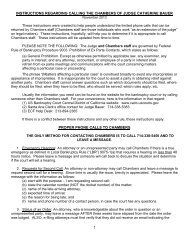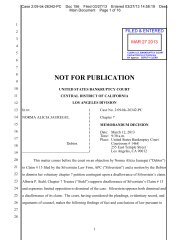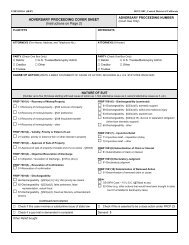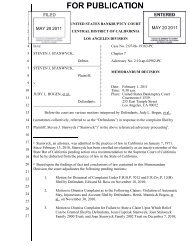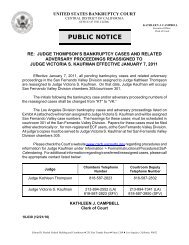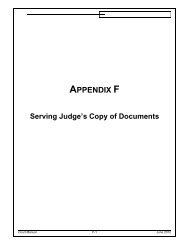Robert DeGour and Lynn Randle - Central District of California
Robert DeGour and Lynn Randle - Central District of California
Robert DeGour and Lynn Randle - Central District of California
Create successful ePaper yourself
Turn your PDF publications into a flip-book with our unique Google optimized e-Paper software.
1<br />
2<br />
3<br />
4<br />
5<br />
6<br />
7<br />
8<br />
9<br />
10<br />
11<br />
12<br />
13<br />
14<br />
15<br />
16<br />
17<br />
18<br />
19<br />
20<br />
21<br />
22<br />
23<br />
24<br />
25<br />
26<br />
27<br />
28<br />
Case 6:11-bk-30010-DS Doc 76 Filed 08/24/12 Entered 08/24/12 14:45:27 Desc<br />
Main Document Page 1 <strong>of</strong> 11<br />
In re:<br />
<strong>Robert</strong> <strong>DeGour</strong> <strong>and</strong> <strong>Lynn</strong> R<strong>and</strong>le,<br />
FOR PUBLICATION<br />
UNITED STATES BANKRUPTCY COURT<br />
CENTRAL DISTRICT OF CALIFORNIA<br />
Debtors.<br />
RIVERSIDE DIVISION<br />
Case No.: 6:11-bk-30010-DS<br />
Chapter: 12<br />
MEMORANDUM DECISION RE<br />
TRUSTEE’S MOTION TO DISMISS<br />
BANKRUPTCY CASE<br />
Before the court is the motion (the “Motion,” docket no. 26) filed by Wesley H.<br />
Avery, the chapter 12 trustee (the “Trustee”), to dismiss this case because the debtors are<br />
not eligible for relief under chapter 12. The Bank <strong>of</strong> New York Mellon Trust Company, N.A.<br />
(“Mellon”), a creditor <strong>of</strong> the debtors, supports the Motion. <strong>Robert</strong> <strong>DeGour</strong> <strong>and</strong> <strong>Lynn</strong> R<strong>and</strong>le<br />
(the “Debtors”) oppose the Motion.<br />
FILED & ENTERED<br />
AUG 24 2012<br />
CLERK U.S. BANKRUPTCY COURT<br />
<strong>Central</strong> <strong>District</strong> <strong>of</strong> <strong>California</strong><br />
BY jeanmari DEPUTY CLERK<br />
There is little guidance from case law regarding the chapter 12 eligibility issues<br />
raised in the Motion. At the court’s request, the parties submitted supplemental briefs <strong>and</strong><br />
evidence on a number <strong>of</strong> issues <strong>and</strong> appeared at several hearings on the Motion. When<br />
the parties submitted their final briefs <strong>and</strong> appeared at the final hearing on the Motion, the<br />
question presented was clear: whether the gross income <strong>of</strong> a non-farming <strong>California</strong><br />
subchapter S corporation wholly owned by the Debtor wife should be included in the<br />
Debtors’ gross income when determining whether the Debtors had sufficient farming<br />
MEMORANDUM DECISION RE TRUSTEE’S MOTION TO DISMISS BANKRUPTCY CASE -1-
1<br />
2<br />
3<br />
4<br />
5<br />
6<br />
7<br />
8<br />
9<br />
10<br />
11<br />
12<br />
13<br />
14<br />
15<br />
16<br />
17<br />
18<br />
19<br />
20<br />
21<br />
22<br />
23<br />
24<br />
25<br />
26<br />
27<br />
28<br />
Case 6:11-bk-30010-DS Doc 76 Filed 08/24/12 Entered 08/24/12 14:45:27 Desc<br />
Main Document Page 2 <strong>of</strong> 11<br />
income to be eligible chapter 12 debtors. To answer this question, the court must also<br />
determine the meaning <strong>of</strong> “gross income,” a term used but not defined in section 101(18)<br />
<strong>of</strong> the Bankruptcy Code, in the context <strong>of</strong> determining chapter 12 eligibility.<br />
Having considered the Motion <strong>and</strong> related pleadings, the record in this case, the<br />
evidentiary objections <strong>of</strong> the parties, <strong>and</strong> the arguments <strong>of</strong> counsel at the hearings, the<br />
court makes the following findings <strong>of</strong> fact <strong>and</strong> conclusions <strong>of</strong> law 1 pursuant to Federal Rule<br />
<strong>of</strong> Civil Procedure 52(a)(1), 2 as incorporated by Federal Rule <strong>of</strong> Bankruptcy Procedure<br />
7052.<br />
I. JURISDICTION<br />
The bankruptcy court has jurisdiction over this case pursuant to 28 U.S.C. §§ 157(b)<br />
<strong>and</strong> 1334(b). The Trustee’s Motion is a core proceeding under 28 U.S.C. § 157(b)(2)(A).<br />
Venue is appropriate in this court. 28 U.S.C. § 1409(a).<br />
II. INTRODUCTION<br />
The Debtors filed a voluntary chapter 12 petition on June 18, 2011. The Debtors<br />
reside at 38770 Avenida La Cresta, Murrieta, <strong>California</strong> 92562 (the “Property”), where they<br />
also operate two businesses: (1) Bootin’ Digger Equine (“BDE”), a sole proprietorship<br />
owned <strong>and</strong> operated by the Debtor husb<strong>and</strong> since 1991 to breed, raise <strong>and</strong> sell horses;<br />
<strong>and</strong> (2) ADR Associates, Inc. (“ADR”), a <strong>California</strong> subchapter S corporation owned <strong>and</strong><br />
operated by the Debtor wife as a marketing <strong>and</strong> consulting business. The Property<br />
includes a barn, corral, portable horse stalls <strong>and</strong> a riding arena used for BDE’s operations.<br />
In Schedule I, the Debtors disclosed average monthly income <strong>of</strong> $32,966, consisting<br />
<strong>of</strong> $16,730 in regular income from BDE, $15,101 in regular income from ADR, $623 from<br />
pension or retirement income <strong>and</strong> $512 from alimony. Also in Schedule I, the Debtor<br />
husb<strong>and</strong> listed his occupation as “Horse Breeder/Owner” <strong>and</strong> the name <strong>of</strong> his employer as<br />
1 To the extent that any finding <strong>of</strong> fact is construed to be a conclusion <strong>of</strong> law, it is hereby adopted as such.<br />
To the extent that any conclusion <strong>of</strong> law is construed to be a finding <strong>of</strong> fact, it is hereby adopted as such.<br />
2 Unless otherwise indicated, all “Code,” “chapter” <strong>and</strong> “section” references are to the Bankruptcy Code, 11<br />
U.S.C. §§ 101-1532 <strong>and</strong> all “Rule” references are to the Federal Rules <strong>of</strong> Bankruptcy Procedure (“FRBP”)<br />
which make applicable certain Federal Rules <strong>of</strong> Civil Procedure (”FRCP”).<br />
MEMORANDUM DECISION RE TRUSTEE’S MOTION TO DISMISS BANKRUPTCY CASE -2-
1<br />
2<br />
3<br />
4<br />
5<br />
6<br />
7<br />
8<br />
9<br />
10<br />
11<br />
12<br />
13<br />
14<br />
15<br />
16<br />
17<br />
18<br />
19<br />
20<br />
21<br />
22<br />
23<br />
24<br />
25<br />
26<br />
27<br />
28<br />
Case 6:11-bk-30010-DS Doc 76 Filed 08/24/12 Entered 08/24/12 14:45:27 Desc<br />
Main Document Page 3 <strong>of</strong> 11<br />
“Bootin’ Digger Equine,” <strong>and</strong> the Debtor wife listed her occupation as<br />
“Consultant/President” <strong>and</strong> the name <strong>of</strong> her employer as “ADR Associates, Inc.” In<br />
response to question 1 on the Statement <strong>of</strong> Financial Affairs, the Debtors disclosed that<br />
they earned $210,718 in 2010 from employment or operation <strong>of</strong> business, attributable to<br />
“H: $119,112.00, W: $91,606.00.” 3<br />
On September 29, 2011, the Trustee filed his Motion seeking dismissal <strong>of</strong> this case<br />
because the Debtors are not eligible for chapter 12 relief under 11 U.S.C. §§ 109(f) <strong>and</strong><br />
101(18). 4 The Trustee determined that the Debtors had received only $84,912 from BDE<br />
in 2010 compared to $91,606 from ADR in 2010, based on federal income tax returns,<br />
monthly operating reports, business pr<strong>of</strong>it <strong>and</strong> loss statements <strong>and</strong> other documents<br />
received from the Debtors as well as the Debtors’ testimony at the section 341(a) meeting<br />
<strong>of</strong> creditors. The Trustee contended that a $34,200 “management fee” paid from ADR to<br />
BDE was “a phantom bookkeeping entry which is not reflected on the Debtors’ tax return.”<br />
Subtracting the 2010 “management fee” from the Debtors’ purported $119,112 gross<br />
income from BDE left total gross income from BDE <strong>of</strong> $84,912—less than the $91,606<br />
gross income from ADR. Thus, argued the Trustee, the Debtors did not meet the definition<br />
<strong>of</strong> “family farmer” under section 101(18) <strong>and</strong> were ineligible for relief under chapter 12<br />
pursuant to section 109(f) because less than one-half <strong>of</strong> their income in the taxable year<br />
preceding the filing <strong>of</strong> the petition (i.e., 2010) was derived from farming operations. 5<br />
The Debtors filed an opposition to the Motion arguing, in part, that the management<br />
fee issue was irrelevant because “ADR’s gross income should not be counted in the<br />
income analysis, only salary paid, distributions paid, <strong>and</strong> net income should be attributed<br />
3 The court presumes that “H” <strong>and</strong> “W” mean “husb<strong>and</strong>” <strong>and</strong> “wife.”<br />
4 The Trustee (<strong>and</strong> later, Mellon) raised several grounds for dismissal. They asserted that the Debtors were<br />
ineligible for relief under chapter 12 because they did not engage in a traditional “farming operation,” did not<br />
have sufficient regular annual income <strong>and</strong> did not meet either the debt or income tests. The court is only<br />
ruling on the income test.<br />
5 The Trustee also contended that the Debtors did not receive more than one-half <strong>of</strong> their income from<br />
farming operations in each <strong>of</strong> the second <strong>and</strong> third taxable years preceding the petition date (i.e., 2008 <strong>and</strong><br />
2009). The Debtors concede that they do not meet the chapter 12 eligibility requirement based on 2008 <strong>and</strong><br />
2009 gross income.<br />
MEMORANDUM DECISION RE TRUSTEE’S MOTION TO DISMISS BANKRUPTCY CASE -3-
1<br />
2<br />
3<br />
4<br />
5<br />
6<br />
7<br />
8<br />
9<br />
10<br />
11<br />
12<br />
13<br />
14<br />
15<br />
16<br />
17<br />
18<br />
19<br />
20<br />
21<br />
22<br />
23<br />
24<br />
25<br />
26<br />
27<br />
28<br />
Case 6:11-bk-30010-DS Doc 76 Filed 08/24/12 Entered 08/24/12 14:45:27 Desc<br />
Main Document Page 4 <strong>of</strong> 11<br />
to <strong>Lynn</strong>.” The Trustee filed a reply to the Debtors’ response, asserting that the Debtors<br />
were merely sidestepping the “farm income” requirement “by arguing (without any citation<br />
to authority) that the gross income <strong>of</strong> the Horse Ranch should be counted in toto while only<br />
the net income <strong>of</strong> ADR should be also counted under Section 101(18)(A) because ADR is<br />
an ‘S’ Corporation owned wholly by the Wife <strong>and</strong> not a dba like the Horse Ranch.” Mellon,<br />
while not formally joining the Trustee’s Motion, asserted the same eligibility arguments as<br />
the Trustee in connection with a plan objection, <strong>and</strong> the court heard all eligibility arguments<br />
together. 6<br />
After the first scheduled oral argument, the court continued the hearing to allow the<br />
Debtors additional time to file their individual 2010 federal tax return <strong>and</strong> to allow all parties<br />
an opportunity to further brief the chapter 12 eligibility requirements after reviewing the tax<br />
documents. The Debtors filed both their individual 2010 federal tax return <strong>and</strong> ADR’s 2010<br />
federal tax return <strong>and</strong> stipulated with the Trustee <strong>and</strong> Mellon to a further continuance <strong>of</strong> the<br />
hearing <strong>and</strong> related briefing deadlines.<br />
At the continued hearing, the court heard further argument on the Motion where the<br />
Debtors argued vigorously that ADR’s gross income should be excluded from gross<br />
income for determining eligibility under sections 109(f) <strong>and</strong> 101(18)(A). The Trustee <strong>and</strong><br />
Mellon opposed this argument just as vigorously, <strong>and</strong> during the hearing, the parties <strong>and</strong><br />
the court addressed several issues that were not adequately addressed in the previous<br />
briefing. The court continued the hearing once again <strong>and</strong> requested supplemental briefing<br />
from all parties on two issues: (1) whether the gross income <strong>of</strong> ADR should be included in<br />
the calculation <strong>of</strong> the Debtors’ total gross income when determining eligibility for chapter<br />
12; <strong>and</strong> (2) whether the monies derived from BDE’s sales <strong>of</strong> horses should be included as<br />
gross income or capital gains when determining the Debtors’ gross income for establishing<br />
chapter 12 eligibility. 7<br />
6 Mellon later filed a joinder to the Motion on January 31, 2012.<br />
7 Initially, the parties disagreed whether income from BDE’s horse sales should be classified as income or<br />
capital gains. Because this issue does not materially affect the legal analysis before the court, all monies<br />
derived from the horse sales will be treated as gross income <strong>of</strong> the Debtors.<br />
MEMORANDUM DECISION RE TRUSTEE’S MOTION TO DISMISS BANKRUPTCY CASE -4-
1<br />
2<br />
3<br />
4<br />
5<br />
6<br />
7<br />
8<br />
9<br />
10<br />
11<br />
12<br />
13<br />
14<br />
15<br />
16<br />
17<br />
18<br />
19<br />
20<br />
21<br />
22<br />
23<br />
24<br />
25<br />
26<br />
27<br />
28<br />
Case 6:11-bk-30010-DS Doc 76 Filed 08/24/12 Entered 08/24/12 14:45:27 Desc<br />
Main Document Page 5 <strong>of</strong> 11<br />
At the final hearing before the court, the parties effectively resolved all factual<br />
disputes. The parties agreed that BDE earned $86,030 in gross income in 2010, that ADR<br />
earned $91,606 in gross income in 2010 <strong>and</strong> that the Debtors earned $14,248 in non-farm<br />
income unrelated to ADR in 2010. The only remaining issue before the court was a legal<br />
determination: whether, under the relevant statutory provisions, the court should include<br />
ADR’s gross income when calculating the Debtors’ total gross income for purposes <strong>of</strong><br />
determining chapter 12 eligibility under section 101(18)(A). After the hearing, the court<br />
took the matter under advisement to consider this issue.<br />
A. Introduction<br />
III. DISCUSSION<br />
Dismissal <strong>of</strong> the case centers on the question outlined above: whether the Debtors<br />
earned more than one-half <strong>of</strong> their 2010 gross income from farming operations to qualify<br />
as “family farmers” eligible to file chapter 12. If, as the Debtors argue, the court excludes<br />
ADR’s gross income when calculating the Debtors’ total gross income for eligibility<br />
purposes, the Debtors satisfy the 50 percent “farm income” requirement <strong>and</strong> are eligible<br />
debtors under chapter 12. However, if, as Mellon <strong>and</strong> the Trustee argue, ADR’s gross<br />
income is included in the calculation, the Debtors are ineligible for chapter 12 relief<br />
because they fail to meet the 50 percent “farm income” threshold.<br />
B. “Gross Income” for Determining Chapter 12 Eligibility is the Tax Code’s Definition<br />
<strong>of</strong> “Gross Income”<br />
Only a “family farmer” or “family fisherman” with “regular annual income” is eligible<br />
to be a debtor under chapter 12. 11 U.S.C. § 109(f). A “family farmer” may be either an<br />
individual or a corporation or partnership. See 11 U.S.C. § 101(18). Individuals (<strong>and</strong> their<br />
spouses) are “family farmers” if: (1) they are engaged in farming operations; (2) their debts<br />
do not exceed $3,792,650; (3) at least 50 percent <strong>of</strong> their noncontingent, liquidated debts<br />
(excluding any debt for the principal residence unless such debt arises out <strong>of</strong> a farming<br />
operation) arose out <strong>of</strong> their farming operations; <strong>and</strong> (4) they received at least 50 percent<br />
<strong>of</strong> their gross income from farming operations in the preceding tax year or in each <strong>of</strong> the<br />
MEMORANDUM DECISION RE TRUSTEE’S MOTION TO DISMISS BANKRUPTCY CASE -5-
1<br />
2<br />
3<br />
4<br />
5<br />
6<br />
7<br />
8<br />
9<br />
10<br />
11<br />
12<br />
13<br />
14<br />
15<br />
16<br />
17<br />
18<br />
19<br />
20<br />
21<br />
22<br />
23<br />
24<br />
25<br />
26<br />
27<br />
28<br />
Case 6:11-bk-30010-DS Doc 76 Filed 08/24/12 Entered 08/24/12 14:45:27 Desc<br />
Main Document Page 6 <strong>of</strong> 11<br />
second <strong>and</strong> third tax years preceding filing. 11 U.S.C. § 101(18)(A) (emphasis added). 8<br />
Only the fourth prong—the “farm income” test—is at issue here.<br />
To analyze this “farm income” requirement, a bankruptcy court must initially<br />
determine the amount <strong>of</strong> the debtor’s gross income during the relevant tax year <strong>and</strong> then<br />
determine the portion <strong>of</strong> that income attributable to the farming operation. See 2 Collier on<br />
Bankruptcy 101.18[6] (16th ed. rev. 2010). This dispute centers on the appropriate<br />
definition <strong>of</strong> “gross income” as it is used to analyze the “farm income” test <strong>of</strong> section<br />
101(18)(A). Because the Bankruptcy Code does not define the term “gross income,” the<br />
court must look elsewhere for guidance.<br />
Courts are split as to the appropriate definition <strong>of</strong> “gross income” for determining<br />
chapter 12 eligibility. The majority line <strong>of</strong> cases follows the decision <strong>of</strong> the Seventh Circuit<br />
Court <strong>of</strong> Appeals in Matter <strong>of</strong> Wagner, 808 F.2d 542, 549 (7th Cir. 1986) to import the<br />
federal Tax Code definition <strong>of</strong> “gross income” when determining whether the “farm income”<br />
test <strong>of</strong> section 101(18)(A) is met. 9 See In re Lewis, 401 B.R. 431, 441 (Bankr. C.D. Cal.<br />
2009); The Cadle Co. v. King (In re King), 272 B.R. 281, 293 (Bankr. N.D. Okla. 2002); In<br />
re Gregerson, 269 B.R. 36, 40 (Bankr. N.D. Iowa 2001) (“Courts have used the tax law<br />
meaning <strong>of</strong> ‘gross income’ in making chapter 12 eligibility decisions.”); In re Lamb, 209<br />
B.R. 759, 760-61 (Bankr. M.D. Ga. 1997) (“Congress intended the term ‘gross income’ to<br />
have its ordinary Tax Code meaning.”); In re Fogle, 87 B.R. 493, 496 (Bankr. N.D. Ohio<br />
1988); In re Pratt, 78 B.R. 277, 279 (Bankr. D. Mont. 1987); In re Faber, 78 B.R. 934, 935<br />
(Bankr. S.D. Iowa 1987); Matter <strong>of</strong> Schafroth, 81 B.R. 509 (Bankr. S.D. Iowa 1987).<br />
“Indeed, in determining eligibility for chapter 12, some courts have refused to consider<br />
8 Section 101(18)(A) provides, in relevant part:<br />
[A]n individual or individual <strong>and</strong> spouse, must receive from such farming operation more than<br />
50 percent <strong>of</strong> such individual’s or such individual <strong>and</strong> spouse’s gross income for (i) the<br />
taxable year preceding; or (ii) each <strong>of</strong> the 2d <strong>and</strong> 3d taxable years preceding the taxable<br />
year in which the case concerning such individual or such individual <strong>and</strong> spouse was filed.<br />
11 U.S.C. § 101(18)(A).<br />
9 26 U.S.C. § 61 provides that “gross income means all income from whatever source derived, including (but<br />
not limited to) the following items . . . (2) gross income from business.” 26 U.S.C. § 61(a)(2).<br />
MEMORANDUM DECISION RE TRUSTEE’S MOTION TO DISMISS BANKRUPTCY CASE -6-
1<br />
2<br />
3<br />
4<br />
5<br />
6<br />
7<br />
8<br />
9<br />
10<br />
11<br />
12<br />
13<br />
14<br />
15<br />
16<br />
17<br />
18<br />
19<br />
20<br />
21<br />
22<br />
23<br />
24<br />
25<br />
26<br />
27<br />
28<br />
Case 6:11-bk-30010-DS Doc 76 Filed 08/24/12 Entered 08/24/12 14:45:27 Desc<br />
Main Document Page 7 <strong>of</strong> 11<br />
anything besides the debtor’s tax return.” Gregerson, 269 B.R. at 40; see also In re<br />
Bergmann, 78 B.R. 911, 912 (Bankr. S.D. Ill. 1987); In re Nelson, 73 B.R. 363, 365 (Bankr.<br />
D. Kan. 1987).<br />
The minority line <strong>of</strong> cases adopts a more flexible, case-by-case approach outlined<br />
by In re Rott, 73 B.R. 366 (Bankr. D.N.D. 1987). The Rott court reasoned that “[w]hile<br />
there certainly is merit to these reasons [to follow the Wagner Tax Code approach], this<br />
court does not believe that judicial economy, procedural convenience, <strong>and</strong> predictability<br />
should be placed above the flexible nature <strong>of</strong> the Bankruptcy Code, <strong>and</strong> the objective <strong>of</strong><br />
reaching just <strong>and</strong> equitable results for both parties. The circumstances <strong>of</strong> each case shall<br />
be considered because ‘gross income’ is not an accounting term capable <strong>of</strong> precise<br />
definition.” Rott, 73 B.R. at 371-72; see also Cottonport Bank v. Dichiara, 193 B.R. 798<br />
(W.D. La. 1996); In re Way, 120 B.R. 81 (Bankr. S.D. Tex. 1990).<br />
Here, relying on the majority interpretation, the Trustee <strong>and</strong> Mellon argue that<br />
because the Tax Code defines “gross income” to include “all income from whatever source<br />
derived, including (but not limited to) . . . (2) gross income from business,” ADR’s total<br />
gross income must be included in the calculation <strong>of</strong> the Debtors’ gross income under<br />
section 101(18)(A), resulting in farm income <strong>of</strong> less than 50 percent <strong>of</strong> gross income <strong>and</strong><br />
rendering them ineligible for chapter 12. Relying on the minority interpretation, the Debtors<br />
argue that the Tax Code is too rigid to determine “gross income” in the bankruptcy context,<br />
<strong>and</strong> that the court should consider the “totality <strong>of</strong> the circumstances” instead <strong>of</strong> relying on a<br />
mechanical approach.<br />
This court finds the majority interpretation more persuasive. As the Seventh Circuit<br />
recognized in Wagner, a bankruptcy court must have a reliable mechanism to answer a<br />
fundamental question: is the subject debtor a “farmer” under the Bankruptcy Code? The<br />
gross income guidelines outlined by the Tax Code <strong>and</strong> applicable case law <strong>of</strong>fer such a<br />
mechanism to determine whether debtors are farmers entitled to relief under chapter 12, or<br />
whether they should file under a more appropriate chapter. Wagner explains that by<br />
MEMORANDUM DECISION RE TRUSTEE’S MOTION TO DISMISS BANKRUPTCY CASE -7-
1<br />
2<br />
3<br />
4<br />
5<br />
6<br />
7<br />
8<br />
9<br />
10<br />
11<br />
12<br />
13<br />
14<br />
15<br />
16<br />
17<br />
18<br />
19<br />
20<br />
21<br />
22<br />
23<br />
24<br />
25<br />
26<br />
27<br />
28<br />
Case 6:11-bk-30010-DS Doc 76 Filed 08/24/12 Entered 08/24/12 14:45:27 Desc<br />
Main Document Page 8 <strong>of</strong> 11<br />
enacting section 101(17), 10 Congress was not using the word “farmer” in its ordinary-<br />
language sense, as it had been used by previous law, because “[i]t had led to excessive<br />
uncertainty in application <strong>and</strong> was ab<strong>and</strong>oned for a mechanical approach in which ‘farmer’<br />
is a technical term” that is based on, among other factors, whether the debtor meets the<br />
statutory “farm income” threshold for the preceding taxable year. Wagner, 808 F.2d at<br />
546. Wagner further notes that “[f]rom the statutory references to ‘taxable year’ <strong>and</strong> ‘gross<br />
income,’ both themselves technical terms, though <strong>of</strong> tax law rather than bankruptcy law, it<br />
is possible to infer that Congress intended to use these terms in section 101(17) in their<br />
tax sense.” Id.<br />
Contrary to the Debtors’ argument, using the Tax Code definition <strong>of</strong> “gross income”<br />
does allow a court to consider the totality <strong>of</strong> the circumstances in determining eligibility,<br />
including in the assessment <strong>of</strong> whether debtors are engaged in farming operations <strong>and</strong><br />
what portion <strong>of</strong> their debt arises out <strong>of</strong> farming operations. Section 101(18)(A) even<br />
permits debtors to meet the “farm income” test for the second <strong>and</strong> third taxable years<br />
before the petition date if they cannot meet the test for the taxable year immediately before<br />
the petition date, which again permits flexibility in establishing eligibility while giving the<br />
inquiry a needed level <strong>of</strong> certainty.<br />
Therefore, in determining whether the Debtors meet the “farm income” test <strong>of</strong><br />
section 101(18)(A), the court will look to the Tax Code for the definition <strong>of</strong> the Debtors’<br />
“gross income.”<br />
C. The Debtors’ Gross Income Includes Gross Income from a Subchapter S<br />
Corporation Owned by the Debtors<br />
The inquiry does not end with the court’s adoption <strong>of</strong> the Tax Code’s definition <strong>of</strong><br />
gross income. The court must still determine whether the gross income <strong>of</strong> ADR, a<br />
subchapter S corporation wholly owned by the Debtor wife, is gross income <strong>of</strong> the debtors.<br />
10 Section 101(17) is now section 101(18).<br />
MEMORANDUM DECISION RE TRUSTEE’S MOTION TO DISMISS BANKRUPTCY CASE -8-
1<br />
2<br />
3<br />
4<br />
5<br />
6<br />
7<br />
8<br />
9<br />
10<br />
11<br />
12<br />
13<br />
14<br />
15<br />
16<br />
17<br />
18<br />
19<br />
20<br />
21<br />
22<br />
23<br />
24<br />
25<br />
26<br />
27<br />
28<br />
Case 6:11-bk-30010-DS Doc 76 Filed 08/24/12 Entered 08/24/12 14:45:27 Desc<br />
Main Document Page 9 <strong>of</strong> 11<br />
Under the Tax Code, gross income is defined as “all income from whatever source<br />
derived.” 26 U.S.C. § 61(a). Within this definition are several enumerated types <strong>of</strong><br />
income, including “gross income from business.” 26 U.S.C. § 61(a)(2). Thus, if the<br />
Debtors receive income from the ADR business, it appears that such income would be<br />
included in the computation <strong>of</strong> total gross income under the Tax Code. However, the<br />
Debtors contend that ADR’s gross income is not “gross income from business” <strong>of</strong> the<br />
Debtors but rather <strong>of</strong> a separate corporation. They argue that ADR is a “separate, st<strong>and</strong>-<br />
alone” corporate entity that must “pay its own bills” before any funds are available for the<br />
Debtors’ use, <strong>and</strong> therefore its gross income should not be part <strong>of</strong> the Debtors’ gross<br />
income.<br />
There is no binding authority regarding whether gross income from a wholly-owned<br />
subchapter S corporation should be included in a debtor’s gross income for purposes <strong>of</strong><br />
determining whether the debtor meets the 50 percent “farm income” test for chapter 12<br />
eligibility. However, at least one bankruptcy court has held that gross income as defined<br />
by the Tax Code includes income from a subchapter S corporation owned by the debtor<br />
<strong>and</strong> should be taken into account in determining whether a debtor qualifies as a “family<br />
farmer.” Matter <strong>of</strong> Schafroth, 81 B.R. 509 (Bankr. S.D. Iowa 1987). In Schafroth, the court<br />
reasoned that because “[i]ncome from a closely held corporation that qualifies as a<br />
subchapter S corporation passes through the corporation to the shareholders . . . the<br />
corporation’s income would be attributable to the debtors if [it] were a subchapter S<br />
corporation.” Schafroth, 81 B.R. at 511-12. Under 26 U.S.C. § 1366(b), income derived<br />
from a subchapter S corporation “passes through” to the shareholder as ordinary income. 11<br />
11 Section 1366(b) <strong>and</strong> (c) provide:<br />
(b) The character <strong>of</strong> any item included in a shareholder’s pro rata share under paragraph (1)<br />
<strong>of</strong> subsection (a) shall be determined as if such item were realized directly from the source<br />
from which realized by the corporation, or incurred in the same manner as incurred by the<br />
corporation.<br />
(c) In any case where it is necessary to determine the gross income <strong>of</strong> a shareholder for<br />
purposes <strong>of</strong> this title, such gross income shall include the shareholder’s pro rata share <strong>of</strong> the<br />
gross income <strong>of</strong> the corporation.<br />
26 U.S.C. § 1366(b) <strong>and</strong> (c).<br />
MEMORANDUM DECISION RE TRUSTEE’S MOTION TO DISMISS BANKRUPTCY CASE -9-
1<br />
2<br />
3<br />
4<br />
5<br />
6<br />
7<br />
8<br />
9<br />
10<br />
11<br />
12<br />
13<br />
14<br />
15<br />
16<br />
17<br />
18<br />
19<br />
20<br />
21<br />
22<br />
23<br />
24<br />
25<br />
26<br />
27<br />
28<br />
Case 6:11-bk-30010-DS Doc 76 Filed 08/24/12 Entered 08/24/12 14:45:27 Desc<br />
Main Document Page 10 <strong>of</strong> 11<br />
While not binding, Schafroth is well reasoned <strong>and</strong> consistent with the Wagner<br />
definition <strong>of</strong> gross income adopted by this court. Here, ADR is a subchapter S corporation<br />
whose income passes though to its sole shareholder, the Debtor wife, as ordinary income<br />
under the Tax Code. Its income should be included in the Debtors’ gross income.<br />
Finally, the Debtors argue that only ADR’s net income, not its gross income, should<br />
be included in the Debtors’ gross income for the “farm income” test <strong>of</strong> section 101(18)(A).<br />
This argument is inconsistent with Schafroth <strong>and</strong> is inconsistent with analysis <strong>of</strong> the Tax<br />
Code’s definition <strong>of</strong> “gross income.” While “gross income from business” is not defined by<br />
the Tax Code, the Treasury Regulations provide that “[i]n a manufacturing, merch<strong>and</strong>ising,<br />
or mining business, ‘gross income’ means the total sales, less the costs <strong>of</strong> goods sold.“ 26<br />
CFR § 1.61-3(a); see In re Cox, 93 B.R. 625, 627 (Bankr. S.D. Ill. 1988); Faber, 78 B.R. at<br />
93. In contrast, “where a business is engaged primarily in the providing <strong>of</strong> a service, rather<br />
than mining, manufacturing, or merch<strong>and</strong>ising, the business gross receipts will constitute<br />
gross income.” Guy F. Atkinson Co. <strong>of</strong> <strong>California</strong> <strong>and</strong> Subsidiaries v. Comm’r <strong>of</strong> Internal<br />
Revenue, 82 T.C. 275, 298 (1984), aff’d on other grounds 814 F.2d 1388 (9th Cir. 1987);<br />
see also In re Sweitzer, 332 B.R. 614 (Bankr. C.D. Cal. 2005) (court should disallow<br />
deductions from gross receipts where income derived from “rendering <strong>of</strong> services”). Here,<br />
ADR does not engage in manufacturing, mining or merch<strong>and</strong>ising. It is a marketing <strong>and</strong><br />
consulting business that provides services to its clients. ADR’s gross income, without<br />
deductions, should be included in the Debtors’ gross income. 12<br />
12 The Debtors’ argument also treats one business differently from the other. In essence, the Debtors wish to<br />
have gross income from one business, the BDE farming operation, included in the calculation <strong>of</strong> their gross<br />
income, while including only net income (if anything at all) from their other business, the non-farming ADR<br />
business. Not only is the approach contrary to the persuasive authority, it appears self serving <strong>and</strong> internally<br />
inconsistent.<br />
MEMORANDUM DECISION RE TRUSTEE’S MOTION TO DISMISS BANKRUPTCY CASE -10-
1<br />
2<br />
3<br />
4<br />
5<br />
6<br />
7<br />
8<br />
9<br />
10<br />
11<br />
12<br />
13<br />
14<br />
15<br />
16<br />
17<br />
18<br />
19<br />
20<br />
21<br />
22<br />
23<br />
24<br />
25<br />
26<br />
27<br />
28<br />
Case 6:11-bk-30010-DS Doc 76 Filed 08/24/12 Entered 08/24/12 14:45:27 Desc<br />
Main Document Page 11 <strong>of</strong> 11<br />
IV. CONCLUSION<br />
Because ADR’s gross income must be included in the calculation <strong>of</strong> the Debtors’<br />
gross income, the Debtors do not qualify as family farmers under section 101(18)(A) <strong>and</strong><br />
are ineligible to be chapter 12 debtors under section 109(f). The Motion is granted.<br />
The Trustee shall submit a proposed order consistent with this memor<strong>and</strong>um.<br />
DATED: August 24, 2012<br />
###<br />
United States Bankruptcy Judge<br />
MEMORANDUM DECISION RE TRUSTEE’S MOTION TO DISMISS BANKRUPTCY CASE -11-


